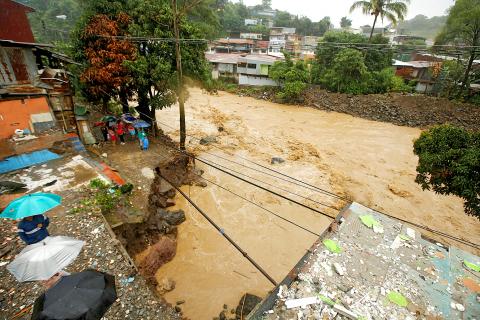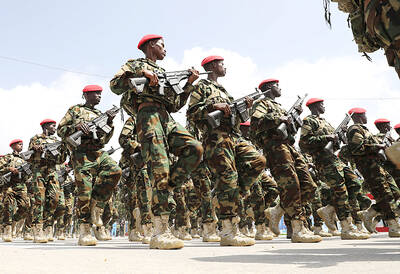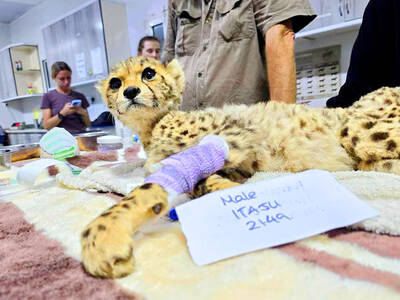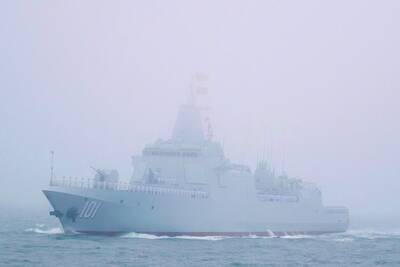Tropical Storm Nate has killed at least 22 people in Central America with torrential rains that forced thousands from their homes, uprooted trees, knocked out bridges and turned roads into rivers, officials said on Thursday.
Forecasters predicted it would strengthen into a hurricane headed for Mexico and the US.
The country hardest hit by the storm that began on Wednesday was Nicaragua, with 11 dead and seven missing, Nicaraguan Vice President Rosario Murillo told state media.

Photo: Reuters
Officials in Costa Rica said eight people died, including a three-year-old girl, after they were hit by falling trees and mudslides, and two young Nicaraguan farm workers. At least 17 people were missing.
Costa Rica declared a national emergency as it struggled with mudslides, washed out roads and overflowing rivers. Schools, universities, government offices and banks across the nation were closed.
Three other people were killed in Honduras.
Murillo said that 800 people had been evacuated, nearly 600 homes were flooded and 14 communities were isolated, because of rains that had been falling for days.
More than 5,000 people were being put up in shelters in Costa Rica after having to abandon their homes because of flooding and the risk of unstable ground giving way, National Emergency Commission Director Ivan Brenes said.
At least 18 main roads were closed and another dozen were only partially open.
In Costa Rica’s northwest Guanacaste region, a popular tourist site, many roads were so flooded as to be impassable to all but four-wheel-drive vehicles and horses.
As of Thursday night Nate was moving northwest along the east coast of Honduras and was expected to reach hurricane strength when it reaches the central Gulf of Mexico late yesterday or early today.
Storm or hurricane watches have been issued from Louisiana east through Mississippi and Alabama, the US National Hurricane Center said in a bulletin at 3am GMT.
Some offshore oil and gas rigs in the Gulf of Mexico were being evacuated ahead of the storm, the US Bureau of Safety and Environmental Enforcement said in a statement.
The US is recovering from two major hurricanes: Hurricane Harvey, which tore through Texas in August, and Hurricane Irma last month.
Another powerful storm, Hurricane Maria, ripped through the Caribbean late last month, wreaking destruction on several islands, including Dominica and Puerto Rico.
In Costa Rica, an alert was issued for people to be wary of crocodiles that might be roaming after rivers and estuaries flooded.
Concerned soccer officials were monitoring the situation and postponed a World Cup qualifying match between Costa Rica and Honduras yesterday and today.
Costa Rica’s main international airport was open, but with multiple flight cancelations and delays.
The annual rainy season is currently under way in Central America, a five-month period typically ending in November in which the risk of flooding and mudslides rise.
This year’s has been intense, with some areas in the region getting up to 50 percent more rain than average for September and October.

ELECTION DISTRACTION? When attention shifted away from the fight against the militants to politics, losses and setbacks in the battlefield increased, an analyst said Recent clashes in Somalia’s semi-autonomous Jubaland region are alarming experts, exposing cracks in the country’s federal system and creating an opening for militant group al-Shabaab to gain ground. Following years of conflict, Somalia is a loose federation of five semi-autonomous member states — Puntland, Jubaland, Galmudug, Hirshabelle and South West — that maintain often fractious relations with the central government in the capital, Mogadishu. However, ahead of elections next year, Somalia has sought to assert control over its member states, which security analysts said has created gaps for al-Shabaab infiltration. Last week, two Somalian soldiers were killed in clashes between pro-government forces and

Ten cheetah cubs held in captivity since birth and destined for international wildlife trade markets have been rescued in Somaliland, a breakaway region of Somalia. They were all in stable condition despite all of them having been undernourished and limping due to being tied in captivity for months, said Laurie Marker, founder of the Cheetah Conservation Fund, which is caring for the cubs. One eight-month-old cub was unable to walk after been tied up for six months, while a five-month-old was “very malnourished [a bag of bones], with sores all over her body and full of botfly maggots which are under the

BRUSHED OFF: An ambassador to Australia previously said that Beijing does not see a reason to apologize for its naval exercises and military maneuvers in international areas China set off alarm bells in New Zealand when it dispatched powerful warships on unprecedented missions in the South Pacific without explanation, military documents showed. Beijing has spent years expanding its reach in the southern Pacific Ocean, courting island nations with new hospitals, freshly paved roads and generous offers of climate aid. However, these diplomatic efforts have increasingly been accompanied by more overt displays of military power. Three Chinese warships sailed the Tasman Sea between Australia and New Zealand in February, the first time such a task group had been sighted in those waters. “We have never seen vessels with this capability

‘NO INTEGRITY’: The chief judge expressed concern over how the sentence would be perceived given that military detention is believed to be easier than civilian prison A military court yesterday sentenced a New Zealand soldier to two years’ detention for attempting to spy for a foreign power. The soldier, whose name has been suppressed, admitted to attempted espionage, accessing a computer system for a dishonest purpose and knowingly possessing an objectionable publication. He was ordered into military detention at Burnham Military Camp near Christchurch and would be dismissed from the New Zealand Defence Force at the end of his sentence. His admission and its acceptance by the court marked the first spying conviction in New Zealand’s history. The soldier would be paid at half his previous rate until his dismissal